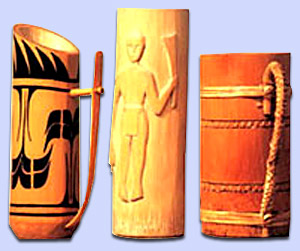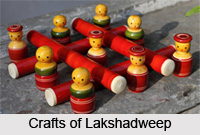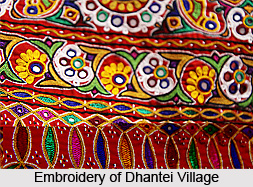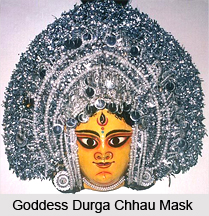 Mask is basically an important part of theatre craft that has been connected with the rituals and Indian history since antiquity. India is the place where such theatre crafts are in huge demand because of the fact that India is the centre of theatre and drama. Masks of different culture and times connote that masks existed since the ancient tradition.
Mask is basically an important part of theatre craft that has been connected with the rituals and Indian history since antiquity. India is the place where such theatre crafts are in huge demand because of the fact that India is the centre of theatre and drama. Masks of different culture and times connote that masks existed since the ancient tradition.
The word `mask` has a foreign origin. It can refer to the French term `masque` or the Italian word `maschera` or the Spanish term `máscara`. The word is also considered to have its origins in the Latin words `mascus` and `masca` which connote ghost. Even Arabic term `maskharah` which is another originator of the term `mask` implies jester or man in masquerade. The history says that masks have been used since antiquity for both ceremonial and practical purposes in India.
Masks are made in India in several states and this is particularly the art of the tribal people. Sometimes the people of different states make masks to earn their livelihood. There are different kinds of masks like Bhuta Masks of South India, painted mask bastar of Madhya Pradesh, Hanuman masks of Orissa, Papier Mache tiger masks of Himachal Pradesh, Wooden masks of Nepal. Apart from these masks, Karnataka is the centre of a particular mask especially headgears called `Kiritams` which are used by the artists performing Kathakali dance. There are variations in the headgears as different headgears are made to represent different characters. The headgears of religious figures, strong, gentle, devoted, and loyal differs from the headgears of vicious and destructive characters.
Among the other masks made in India, the wooden masks of West Bengal are an important component for the social and cultural activities. The craftsmen of this state, mainly from Purulia, make wooden mask for the `chhou` dancers. In Malda, the masks are used by the `Gambhira` dancers. The tradition of Darjeeling and Tibet also incorporate the use of masks in their devil dances and other religious festivals. `Chhou` masks are discernible as they are the representation of the gods, goddesses and characters from the mythology and history of India. The artisans for `chhou` masks are mostly located in and around Charida and Bagmundi of Purulia district in West Bengal. The artistry of hilly areas allows the wood carving on wood masks which are painted vividly with exclusive tint representing the evil spirits of the mountains and the demons.

Masks are used for their expressive power as a feature of masked performance both ritually and in various theatre traditions. The ritual and theatrical definitions of mask usage frequently overlie and merge but still provide a useful basis for categorisation. The image of juxtaposed Comedy and Tragedy masks are widely used to represent the Performing Arts, and specifically, Drama. Ritual masks are used all over the world. They are highly distinctive in forms and many more forms have developed by the progression of theatre craft and time. The function of the masks may be magical or religious; they may appear in rites of passage or as a make-up for a form of theatre.
Masks share an aesthetic value with the carved images of monstrous heads that dominate the facades of Hindu and Buddhist temples. These faces or Kirtimukhas, `Visages of Glory`, are intended to ward off evil and are consociated with the animal world as well as the divinity. Ramlila performances which are done annually nine days before celebration of Dussehra in various part of Uttar Pradesh gives an ample scope for making masks related to this performance. Generally, costumes and jewellery are cheap ostentatious with bold motifs and designs. Ample use of zardozi embroidery is done to decorate the costumes and the mukuts (head gears) of the performers. Mathura is known for making the mukuts. Large masks depicting animals and human models are made at Ram Nagar.
Masks play the role of familiar and vivid element in many folk and traditional pageants, ceremonies, rituals and festivals which are often of an ancient origin. Having a traditional value, it is important to the religious and social life of the community as whole or a particular group within some community. There are some communities in India, who live on creating this particular item of theatre craft. The artisans follow some ways to give each mask a distinct look. These masks play a key part within world theatre traditions, particularly non-western theatre forms. They also continue to be a vital force within contemporary theatre, and their usage takes a variety of forms. In many cultural traditions the masked performer is a central concept and is highly valued.
There are different types of masks. The masks made for the Kathakali dancers, `Kiritams` made for the `rishis`, hunters and religious figures. These particular masks look different from each other as each `Kiritam` represent separate persona. To make these masks wood is used are decorated with closely knit silver beads on a red scarlet base.
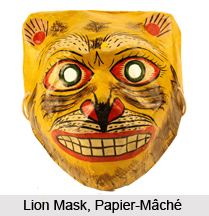 In order to beautify the masks further decoration is done with fixing glass pieces on aluminium foils while large glass flower petals and small silver beads are in the centre. Various other decorations are done with pieces of jewellery, vines of golden stems and leaves, green buds, grapes with peacock feather stems, and a golden circle of foils converging on a round piece of glass in the centre and represent a fully blossomed flower. At first, the fabric to be embroidered is fixed on a wooden frame and stretched tightly. Design is traced on it and with the aid of a needle, zari, stones, salma, sitara etc. is embedded on to it. In case the fabric is to be printed, then it is done with various colours by a brush.
In order to beautify the masks further decoration is done with fixing glass pieces on aluminium foils while large glass flower petals and small silver beads are in the centre. Various other decorations are done with pieces of jewellery, vines of golden stems and leaves, green buds, grapes with peacock feather stems, and a golden circle of foils converging on a round piece of glass in the centre and represent a fully blossomed flower. At first, the fabric to be embroidered is fixed on a wooden frame and stretched tightly. Design is traced on it and with the aid of a needle, zari, stones, salma, sitara etc. is embedded on to it. In case the fabric is to be printed, then it is done with various colours by a brush.
The tradition of masks depicts its existence in India since the antiquity. Even in recent times, the contemporary theatre tradition values the use of the different forms of masks to suit the persona of different characters in dramas and theatres. In some states of India the culture of folk tradition plays a vital role. In this nineteenth century, the artisans are trying to reconstruct the art of making masks by adding modern arts into them.



